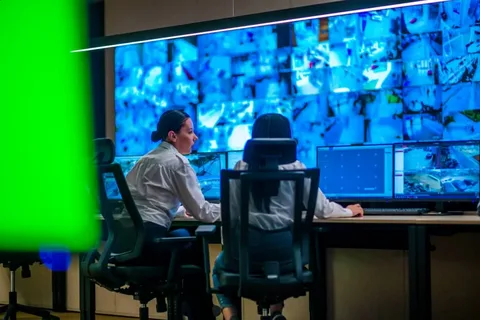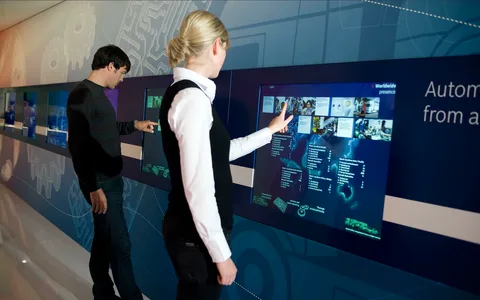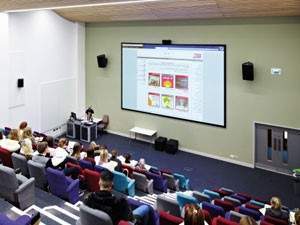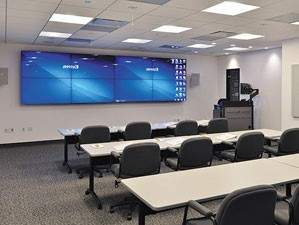
In the last two publications, we described what a technically equipped lecture hall is, where we indicated the purpose and composition of the necessary equipment. They also gave basic recommendations on the choice of functional furniture for full adaptation with multimedia systems.
And continuing the thematic cycle – “Technical equipment of lecture halls”, today’s article will be devoted to another topic, in which we will try to reveal the main points and criteria when choosing and placing equipment for the collective display of graphic information.
The information provided is primarily designed to ensure that any user or buyer understands what are the main factors that affect the correct and efficient equipping of the classroom (a room of more than 50 people). And being a customer, they could pre-calculate everything, and then draw up a complete instruction for the solution integrator on filling and functioning of the future complex.
This review will contain the following sections:
- interactive equipment.
- Projection means of display.
- Video walls.
- Dimensions and placement of equipment.
- Resolution and aspect ratio.


Interactive displays
The choice of means of collective video display primarily depends on the functional purpose, as well as the initial architectural and construction solution of the equipped room (its height, aspect ratio, the presence of columns, outbuildings, etc.). As a rule, in parallel with the choice of equipment, a general layout of the lecture hall is developed, which sets the scheme for seating students, the position of the aisles, the location of the teacher’s chair, the assistant’s workplace, etc.

The use of an interactive whiteboard with a projector (or an interactive projector with a whiteboard screen) or an interactive LCD display as the main display medium is almost impossible due to the small size of the display surfaces. In practice, it is convenient to use them only in short and wide (“square”) semi-stream audiences with a length of no more than 8-9 meters.
In order for the teacher to be able to work at the interactive whiteboard (panel) and present educational material to all students in a quality manner, the system should be built so that the image from interactive tools is duplicated using a powerful multimedia projector on a large projection screen. Or it was broadcast on large-screen flat-panel displays hanging in the middle and rear parts of the room, where it is no longer possible to perceive the image displayed on interactive devices normally.
The interactivity of the presentation of the material can be ensured by installing a special (touch) tablet in the lecturer’s podium with the appropriate software on the teacher’s computer or a smart panel, for example, the Sympodium series from SMART Technologies.
An interactive whiteboard (panel) is more appropriate than a tablet where there may be cases of joint work between a teacher and a student or a discussion of the material is carried out by several people at once.
An interactive projector has less advanced features than a whiteboard with a separate projector, in particular, it can only be operated by one person without the use of multi-touch technology.
Speaking of interactive displays, it can be noted that their use does not require a video projector, and plus everything has more advanced functionality.
Concluding the topic, I must say that you should choose multimedia projectors (short-throw and ultra-short-throw), whose optics allow you to place as close as possible to the board and above its upper edge, for example, on a special wall bracket directly above the board. This will minimize the likelihood of shading the projection beam working near the board.

Projection equipment
The use of a multimedia projector with a large projection screen is the most common option for lecture audiences. Most often, a motorized screen is used (very rarely manual), the deployed canvas of which overlaps or covers part of the marker or chalk board.
There are cases when it is convenient to use permanent (stationary or tension) screens mounted on a rigid frame. They are well stretched, but they are more susceptible to pollution and external climatic influences, which entails a clear deformation of the web. The benefit from the fact that these screens do not have a top box (tube), as in unfolding ones, and they can be placed in low auditoriums right under the ceiling, is apparent.
If you install a similar design close to the ceiling, then the upper part of the projected image will be spoiled (illuminated) by reflections of light from the ceiling. In reality, such a solution is well suited only for educational purposes in old buildings, where some kind of moldings, radii, etc. go along the upper part of the front wall, and the ceiling plane itself turns out to be remote from the surface of the canvas.
Since there is now a wide choice of projection equipment with high light fluxes, the most massive non-perforated white-matte canvases with a wide radiation pattern should be used for display, which ensures good visibility of the picture even from the extreme seats of the front rows in wide audiences. Screens with a low gain (1.3-2.5) should be used only in long and narrow rooms with a significant level of general external illumination. Highly reinforced canvases are generally not applicable in classrooms.
For a rough estimate of the required luminous flux of the projector with a white-matte screen, you can start from the value of 500-900 ANSI lm per square meter of the projected image. The values correspond to the conditions when the auditorium windows are slightly curtained during the projection (rotary blinds, medium-density colored curtains). The more external illumination in the audience, the more powerful the projector is needed.
The struggle for a higher contrast ratio (which manufacturers are so fond of citing in the characteristics of projection equipment and then repeated in the terms of reference of tenders) when choosing a projector for a classroom does not matter. Since the real contrast of the picture will not be thousands or many hundreds, but approximately 1:40-1:70 due to the fact that the training room has a sufficiently high level of stray illumination (natural and artificial lighting).
The high contrast of the projector is only important for city or home cinemas , where various video content is shown in full blackout, and the walls and ceiling are processed so that reflections towards the canvas are minimal.

Video wall display
A more versatile display system are video walls based on LCD panels with sizes from 42” to 65”. This combination of displays allows you to organize split screens of various aspect ratios and scales, the size of which is determined from the architectural features of the lecture hall. Such a technical design is capable of displaying not only one complete image, but also several different images at the same time.
The main advantage of a video wall is the display of a bright and clear video signal of various resolutions, which does not depend on the external level of illumination in the room.
In any case, such complexes are designed individually, requiring a deeper study of details and, unfortunately, are the most expensive means of displaying information

